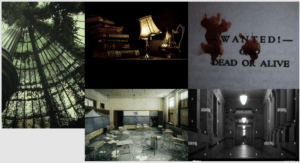Mood Board
Objects
- Dusty books/textbooks
- Filing cabinets, especially rusted ones that make creaky noises
- Water-damaged notebooks
- Worn backpacks
- Cracked glasses
- Desk lamps that are just bright enough to read by, but too dark to illuminate the room
- Teetering piles of unorganized books and papers
- Boxes full of files
- Cobwebs
Locations
- Cramped library work nooks/cubicles
- Empty, dim reading rooms without any windows
- Archives
- Long hallways of shelves
- Dimly lit offices with shuttered windows
- Cluttered desks
- Messy unorthodox workspaces, like in a car
Spotify/Vibes
Playlist I particularly liked:
Other songs from my playlist:

Possible Directions
Types of Fun
Possible type of fun
- Thrilling, escape of evil, of the unknown
- Social connection, connected with the other people in your escape room, united against a single entity
I believe the cornerstone of our fun will be the narrative type of fun. By imbuing a specific, clear narrative that drives decisions in the game and has real consequences, then players will be able to immerse themselves and allow themselves to have suspension of disbelief, making the game more engaging and helping them enjoy the game more.
Make sure it’s grounded, that there’s a human element of motivation, of going forward in the escape room and also trying to figure out the story. Monitor suspension of disbelief and how much we’re expecting escape room attendees to follow along with the narrative before it becomes exhausting.
Narratives
Narrative #1
You’re a student that usually never goes to OH. You decide on the last day of the quarter to go to OH to this random old professor that you never usually go to. The students in the room are dreary, the TAs are gone. Professor has a note that he’s going to be back in some amount of time, but it’s frayed. As the students keep investigating, they suspect more and more that the professor is some sort of cult leader. There are weird pieces of evidence, not sure if it’s left by the professor. The game is investigative, almost like Clue. There’s suspicion whether it’s the TA, or the professor, a large amount of eeriness. You lose all WiFi connection, part of what’s keeping you in there. You know that the professor is going to come back soon, but you have a distinct interest to get to the bottom of what’s happening, especially as a newspaper journalist for the school.That said, you’re also conflicted, as there seems to be no hard evidence that this is all the professor’s wrongdoing. In the end, the professor does turn out to be evil and the head of some cult.
Narrative #2
You go to OH; students seem to all be doing work. There’s a weird amount of other students who are all humming. Paid actors are in the room, NPCs, they don’t really say anything. They’re doing an experiment together. There’s an element of eeriness. You’re not sure if this is even the right class, everyone escorts you in. You realize there’s some sort of weird ritual that’s happening. Everyone leaves the room, you’re alone with other people. Unsure what’s happening next. This narrative is similar to eyes wide shut, it’s unclear what’s happening, and you have to navigate through this weird cult-like organization that’s happening right underneath the school. You try to escape the other student’s nosiness while trying to preserve your own being and escape OH.



